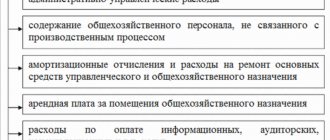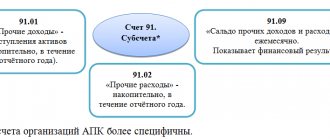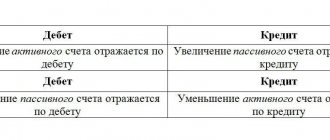As part of this consultation on maintaining 1C on the topic of how to close account 20, as well as other cost accounts - 23, 25, 26 in 1C: Accounting 8.3, we will provide detailed instructions, but we will immediately note that when checking this operation upon completion month, there should be no balances on accounts 25 and 26* at the end of the month; on 20 and 23, on the contrary, there may be a balance for the amount of work in progress, work or services.
*In tax accounting, until December 31, account 26 can be closed with a balance for standardized expenses (for example, advertising expenses).
From the point of view of the cost of goods produced, all expenses are classified as direct or indirect* . The first of them can, without a doubt, be included in the production process of specific types of goods, that is, they can be consumables, salaries of key production personnel, etc. The accounts of such expenses can be viewed in the “Nomenclature group” section, but indirect ones cannot be, because they cannot be attributed to the initial cost of a certain type of product. They are usually attributed, for example, to administrative expenses, payment for the work of the administrative and managerial level, etc.
*This distinction is typical primarily for the accounting of industrial companies.
Figure 1. Cost classification
Scope of application
Every day, company management is faced with management costs that have nothing to do with production, sales or revenue-generating services. The question arises of how to take them into account correctly. Accounting 26 makes it easy to do this. First, all general business expenses are taken into account in this account, and then written off to the debit of accounts 90 “Sales”, 20 “Main production”, 29 “Service of production and economy” or 08 “Investment in non-current assets”, depending on the direction of the main activity of the enterprise.
Money is leaving
The most active users of account 26 are organizations related to the provision of services: dealers, brokers, forwarders, agents. It can include all expenses and be credited to sales accounting.
Trading companies rarely turn to account 26 in their activities. It is easier for them to assign account 44 “Sales expenses” for their business expenses. They attribute all costs to him.
Organizations engaged in agriculture distribute their general business expenses at the close of the reporting period once a month or quarterly by type of production. The exception is the cost of feed, seeds, raw materials for semi-finished products and materials. At the end of the year they are subject to adjustment to the level of actual costs. Also, if the company’s accounting policy allows this, they can be written off to the debit of account 90 “Sales”.
Construction companies, as well as house-building factories, mechanization departments, factories for the production of building materials 26 use accounting accounts to account for the costs of servicing workers, the costs of organizing work on construction sites, and maintaining administrative and economic personnel. General business expenses at the end of the month are written off to the debit of account 20.4 “Costs of construction and installation work.” Factories and house-building plants distribute them according to the types of services provided and products produced. And the mechanization departments are proportionally divided between the services provided to third parties and the construction and installation work performed.
Note! In budget accounting, the purpose of account 26 will be completely different. There it will be off-balance sheet. Budgetary institutions take into account property transferred for free use in accordance with Order of the Ministry of Finance of the Russian Federation No. 157N dated December 1, 2010.
Construction
What does posting d 622 credit 901 mean?
Correspondence by debit The account in question (76) by debit can correspond with the following: “Fixed assets” (01), “Equipment for installation” (07), “Income investments in MC” (03), “Investments in non-current assets” (08 ), “Intangible assets” (04).
From the second section of the chart of accounts, it interacts with the items “Materials” (10), “Animals for growing and fattening” (11), “Procurement and acquisition of MC”. Account 76 can correspond by debit with all items in the “Production Costs” section, as well as with accounts 44, 41, 45 and 43, in the “Finished Products and Goods” category.
Postings are often made with cash accounts: 52, 50, 58, 51, 55, as well as with settlement accounts: 60, 67, 66, 62, 73, 70, 76, 71, 79.
Postings debit 62 and credit 62, 91, 76, 90 (nuances)
When preparing accounting entries, you need to remember the following nuances:
- active accounts can only have a debit balance, while passive accounts can only have a credit balance;
- the increase in passive accounts occurs only by credit, and active accounts - by debit;
- the balance on active-passive accounts can be reflected simultaneously in both liabilities and assets of the balance sheet;
- when compiling a balance sheet, the balances of passive accounts are displayed on the right side, and the balances of active accounts on the left;
- to reduce an active account, you need to make entries on its credit, and to reduce a passive account, you need to make debit entries.
Posting is a way of expressing the correspondence of accounts, the basis for which is a completed business transaction.
Accounting account 76: balance, credit, debit, postings
Type of posting 4: posting that increases the passive account and decreases the passive account With this type of posting we work with the right side of the balance sheet (balance sheet liability), we transfer some liabilities to other liabilities, and the balance sheet does not change from such postings, only the structure of our liability changes balance (i.e. some liabilities increase, and some liabilities decrease). D.84 “Profit” - K.80 “Authorized capital” amount: 100 (profit was redistributed between shareholders, the authorized capital account increased and the profit account account accounted for account 84 decreased) D.60 “Debts to suppliers” - K.60 “ Debts to suppliers” amount: 100 (the supplier assigned our debt to him to another supplier, i.e. we simply transferred our debt from one supplier to another supplier) If we make any of the postings indicated above, then our balance sheet will remain the same: 622.
Accounting for short-term and long-term loans and borrowings (account 66 and 67)
VAT is reflected 76, 60 50, 51 Payment for services is received 60, 76 68 VAT amount is presented for deduction 19 90 Cost of sales expenses are written off 26 With fixed assets If a business entity has fixed assets on its balance sheet that it uses in carrying out business activities, he should draw up correspondence of accounts as follows: Business transaction debit Credit 01 Fixed assets received from suppliers were received on the balance sheet 60 60 Issued invoices were paid 51 07 Associated expenses were reflected 60, 76 07.19/1 All taxes and fees were reflected 68 91/262 Sold fixed assets 0191/1 51 Funds transferred from the buyer 62 91/2 VAT charged 68 02 Accrued depreciation written off 01 Closing the year At the end of each reporting year, the accountant is required to make special entries that will allow closing some accounts.
Accounting entries: what they are and the principles of their preparation
In this regard, it became advisable to open different categories intended for certain types of calculations. Account 76: subaccounts 1 and 2 Since monetary transactions can be different, the account for settlements with creditors and debtors is usually divided into several categories. To the first (76.
1) refers to insurance of property and personnel, with the exception of payments for health and social insurance. Important: Transfers of funds to an organization are reflected in a debit, and write-offs are reflected in a credit. For example, D76 K73 – insurance compensation due to an employee of the organization according to the contract. D51 K76 – receipt of funds by the organization in accordance with regulations.
D99 K76 - write-off of uncompensated insurance claims or damage from a force majeure event.
Features of accounting for settlements with customers (account 62)
When compiling them, it is recommended to adhere to the following scheme:
- It is necessary to determine which accounts and accounting objects are affected by the transaction being processed (its economic content is taken into account).
- It is necessary to establish which accounts will be involved in the posting (passive or active).
- The account to be credited or debited must be determined. To do this, the sources of origin of the operation and all related factors are taken into account.
When making simple entries, two accounts are affected, for example, when money is received at the company's cash desk from the current account, the following entry is made: Kt 51 Dt 50. When making complex entries, several accounting accounts are involved.
How to make accounting entries: basic rules and 11 practical examples
Attention Every specialist applying for the position of accountant must know the chart of accounts of accounting by heart. Thanks to this, he will be able to quickly make a record when completing a particular operation.
What are they? There are two types of entries in accounting: complex and simple.
How to compile them? Basic principles When conducting accounting, specialists will use three types of accounts: active, passive and active-passive.
Incorrect postings and their consequences
Posting type 1: posting that increases the active account and increases the passive account This type of posting is used very often, the most common examples: D.10 “Materials” - K.60 “Debts to suppliers” amount: 100 (materials received, materials warehouse account increased .10 and the debt to the supplier increased (account 60) D.
51 “Bank” - K.67 “Loans” amount: 100 (a loan was received from the bank, the current account account 51 increased and the debt to the bank account 67 increased) D.01 “OS” - K.60 “Debts to suppliers” amount : 100 (fixed assets arrived, the account for accounting for fixed assets account 01 increased and the debt to the supplier account increased.
60) As we see, this type of posting increases the balance of our balance sheet. That is, if we make any of the entries listed above, then our balance sheet will be increased from 622 to 722. Account 76: subaccounts 3 and 4 In paragraph 76.3, control is carried out on dividends due to the company and other types of income that do not contradict the partnership agreement.
D76 K91 – profit to be received (distributed). D51 K76 – funds received by the organization from debtors. The fourth subaccount is intended to take into account amounts accrued to employees of the enterprise, but not paid within a certain period due to the non-appearance of recipients.
In such cases, the following wiring is performed: D70 K76. When a worker receives money, an entry is made to the debit of account 76. Application of subaccount 76/3 in practice You have accounts receivable in the amount of 1,350,000 rubles. on account 62 “Settlements with customers and buyers”.
For certain reasons, before the payment deadline, she transferred for 750,000 rubles.
D76 K68-VAT Identification of budget debt (for VAT) during the determination of revenue for taxation. D76 K26 General business expenses are compensated through various debtors and creditors. D76 K43 Accounting for debts from various debtors for finished products.
D76 K29 The cost of unfinished service production decreased due to the transfer of funds to the organization from debtors.
Loan correspondence Account 76 can interact with the following categories of the chart of accounts: “Investments in non-current assets”, “Fixed assets”, “Intangible assets”, “Equipment for installation”, “Income investments in MC”.
In the “Production Inventories” section, correspondence is carried out with the accounts “Materials”, “Procurement and acquisition of medical supplies”, “Animals for growing and fattening”, “VAT on purchased values”.
Source: https://juristufa.ru/2018/04/19/chto-oznachaet-provodka-d-622-kredit-901/
Account characteristics
What activities can be classified as general business expenses:
- cash payments to employees of the administrative and economic apparatus who do not bring direct income to the company: directorate, accounting department, secretariat. Account 26 reflects wages, bonuses, vacation pay and other incentives paid by the company;
- insurance premiums paid by the company from the earnings of employees of the administrative and economic apparatus, subject to payment to the budget of the Russian Federation;
- depreciation of intangible assets and fixed assets acquired for the needs of the administrative and economic apparatus;
- rent, except for profit-generating premises: production workshops, retail premises, etc.;
- costs of repairing operating systems not related to production activities;
- expenses associated with the provision of consulting and information services;
- costs of materials that will be used for management needs;
- entertainment expenses;
- staff development;
- security of premises;
- recruitment;
- subscription to periodicals;
- software;
- telecommunications, communications, internet;
- business trips of administrative and economic staff.
To account for general business costs, enterprises use a full or partial journal-order form. They reflect information on payroll, consumption of materials, the total amount of wear and tear on the operating system, enter transcript sheets containing various financial expenses, etc.
Note! Payment for services rendered for the maintenance of general business personnel is all 26 accounts.
Education
Case Study
In the limited liability company "Kolobok" during February 2021 on the account. 26 the following expenses were displayed:
- advertising – 40 thousand rubles;
- salary of management staff - 137 thousand rubles. (additionally, accrued insurance premiums were indicated);
- maintenance of the main office - 35 thousand rubles.
The accounting policy of the LLC provides for the monthly closure of the account by assigning the balance directly to the formation of the cost of sales (direct costing).
Accounting entries for business transactions follow below.
Dt 26 Kt 60: 40,000 – reflection of services received on the basis of the act (excluding VAT).
Dt 26 Kt 70: 137,000 – wages accrued.
Dt 26 Kt 69: 41,100 – contributions accrued from employee salaries: 2.9% – social insurance, 22% – pension and 5.1% – medical. The company does not pay contributions for accidents at work.
Dt 90.08 Kt 26,218,100 – closing the month, including general business expenses in the cost of sales of the enterprise.
Closing
To determine active or passive account 26, you need to pay attention to how costs are reflected on it. They are distributed as a debit and written off as a credit to the cost accounts for the main production. Thus, account 26 in the accounting department is active. It closes monthly. All balances are transferred to the cost of production. The balance at the end of the period should be zero.
There are two ways to form costs:
- At actual cost (full).
- Direct costing or at reduced cost.
An enterprise can use only one method in its activities, which must be fixed in its accounting policies. It will not be possible to change it. Closing the account 26 will depend on the chosen method.
If the organization uses the formation method at actual cost, then in this case general business expenses will be closed to account 20 “Main production”. If the company has service or auxiliary workshops that provide services to third parties, then the costs must be divided between accounts 23 “Auxiliary production” and 29 “Service production and facilities”. The procedure for writing off and distributing general business cost bases must also be reflected in the accounting policy. The accounting entry in this case will look like this:
Dt20 (23, 29) - Kt26
How to close the 26th account if the company has chosen the direct costing method. Everything is very simple. General business expenses when working at a reduced cost will be taken into account in account 90.2 “Cost of sales”. Wiring sample:
Dt90.2 - Kt26
In accounting, problems sometimes arise with writing off general business expenses. Why is account 26 not closed? Most likely he has an opening balance, which he shouldn't have. There are several reasons that, by eliminating them, can solve this impossible question:
- First of all, you need to check the accounting policy settings in the accounting program. It should indicate the method of cost formation at the enterprise, as well as information on how general business costs are distributed.
- The second possible reason may be incorrect analytical accounting for general business expenses. You should check the correctness of the distribution of costs by type of item, as well as by division of the company. Most likely, an error will be discovered in the details of the operations performed.
The accountant closes the month
. What to do if there was no revenue during the reporting month. There is also a way out. You need to create a sale for 1 kopeck and send it to a fake counterparty. After this, you can close general business expenses from account 26 to account 20 “Main production”. After this, all that remains is to manually reverse the extra penny at the end of the year.
An example of how to close account 26 manually by posting:
Dt26 - Kt02 - depreciation on fixed assets has been accrued.
Dt26 - Kt10 - inventories are written off.
Dt26 - Kt70 - wages accrued to the administrative and economic apparatus.
Dt26 - Kt68 (69) - insurance payments have been calculated.
Dt20 (21, 29, 90) - Kt26 - costs have been written off.
Important! If general business expenses are taken into account in tax accounting as indirect, then temporary differences invariably arise.
They must also be written off by postings.
Account 02 Depreciation of fixed assets
Depreciation of fixed assets can be calculated in the following ways:
- in a linear way;
- reducing balance method;
- the method of writing off the cost by the sum of the numbers of years of useful life;
- by writing off the cost in proportion to the volume of products (works).
The chosen method is fixed in the accounting policy. You can use different depreciation methods for different groups of homogeneous fixed assets.
Depreciation is accrued monthly starting from the month following the one in which the property was accepted for accounting as a fixed asset.
The amounts of accrued depreciation are written off as expenses for ordinary activities, these are:
Debit 20,23,25,26,29 - Credit 02.
Or included in other expenses (if the object is of a non-production nature or is intended for rent, if rent is not a normal activity):
Debit 91-2 - Credit 02.
If a fixed asset is used to create, modernize or reconstruct another non-current asset, then:
Debit 08 - Credit 02.
How does account 26 correspond with other accounts?
It corresponds with other accounts in the chart of accounts, both in debit and credit. Basic debit entries:
Dt26
Dt26
Correspondence with loan accounting accounts:
Kt26
Indirect costs on accounts 25 and 26
Let's look at indirect costs (Fig. 4). They apply to several types of products at once, so they require distribution. Such costs are taken into account in accounts 25 and 26. These may include the salaries of storekeepers, dispatchers, accountants, the same depreciation (if the equipment is used to produce different types of products), etc.
Fig.4
Indirect costs are distributed among cost items in proportion to the distribution base. In Fig. 4, each cost item has its own color, and each product has a corresponding base (of the same color).
Necessary conditions for distribution:
- for each item a distribution method must be assigned;
- the corresponding base must be “attached” to the product.
For example, the item “Basic materials” is distributed in proportion to the planned cost. This means that this value must be indicated in the program for each product. In 1C, the planned cost is recorded in the document “Setting item prices”.
In Fig. 4, “purple” costs will not be distributed, since the base for them has not been determined. For example, the distribution method “Wages” was set for them, but in the current period there were no direct costs for the corresponding item.
In this case, the 1C 8.3 program will display a list of errors when closing accounts and recommendations for eliminating them (Fig. 5).
Fig.5
To correct it, you need to either enter documents “Reflections of salaries in accounting” for each department, and the salary will have to be attributed to account 20, or change the distribution method for this item (for example, “by output volume”).
Postings
Which entries are most often used in accounting when writing off general business expenses:
- Calculation of depreciation of fixed assets for administrative and economic needs - Dt26 - Kt02.
- Costs associated with OS repairs by the organization itself or with the involvement of third-party specialists - Dt26 - Kt10 (60, 76).
- Depreciation was accrued for intangible assets (intangible assets) for administrative and economic needs - Dt26 - Kt05.
- The costs of renting premises that are not commercial or industrial are reflected - Dt26 - Kt76 (60).
- Costs for audit, information, consulting services - Dt26 - Kt76 (60).
- Expenses for training employees of the administrative and economic apparatus - Dt26 - Kt76 (60).
- Taxes written off - Dt26 - Kt68.
- Salary of administrative and economic personnel - Dt26 - Kt70.
- Insurance premiums - Dt26 - Kt69.
- Conducting official receptions, business meetings and negotiations, transport support - Dt26 - Kt71 (60, 76).
As can be seen from the example entries, all general business expenses are reflected on Dt26, and according to Kt26 they are written off to cost and sales.
A business meeting
Postings for recording general business expenses
All typical accounting entries for accounting are collected in the table:
| Operation description | Debit | Credit |
| Depreciation was accrued for fixed assets and intangible assets used for the administration of the enterprise | 26 | 02 - fixed assets 05 - intangible assets |
| Salaries and insurance contributions were accrued to the director of the organization and his deputies | 70 - salary 69 – contributions | |
| Materials, equipment, special clothing and personal protective equipment used in work for general business needs of the company have been written off. | 10 | |
| Part of the finished products is sent for chemical and chemical work | 43 | |
| Services of third-party organizations are included in the OCR | 60 76 | |
| The deviation in the cost of written-off materials and raw materials for industrial maintenance is reflected | 16 | |
| Semi-finished products are assigned to our own general facilities. company needs | 21 | |
| Part of the costs of main production (goods, works, services) is written off for own needs | 20 | |
| Auxiliary production costs are written off for maintenance | 23 | |
| Costs of servicing production shops are allocated to administrative needs | 29 | |
| Shortages and thefts were written off without identifying the perpetrators. Except for natural disasters | 94 | |
| OHR are included in the reserve for future expenses and payments | 96 | |
| The share of deferred costs is allocated to maintenance and repair | 97 |
How to account for expenses using the cash method
As a general rule, in accounting, expenses are recognized in the reporting period in which they occurred, regardless of the time of actual payment of funds (assuming the temporary certainty of the facts of economic activity). Organizations that have the right to use simplified accounting methods, including simplified accounting (financial) reporting, can use the cash method of accounting for income and expenses. Under the cash method, revenue from the sale of goods (work, services) is recognized after receipt of cash and other forms of payment, and expenses - after repayment of debt (clause 18 PBU 10/99 “Organization expenses”, approved by order of the Ministry of Finance of Russia dated 05/06/1999 No. 33n).
In “1C: Accounting 8” (rev. 3.0), revenue and expenses for accounting purposes can be accounted for without closing documents (“on payment”). With certain assumptions, this method of accounting can be considered the cash method. This method is only available to those who use the following special tax regimes:
- simplified taxation system (STS) with the object “income”;
- unified tax on imputed income (UTII);
- patent taxation system (PTS).
Accounting for expenses in the program without closing documents is based on the assumption that expenses for the purchase of goods (work, services) relate to the reporting period in which they were paid. And settlements with the supplier are made at the time of purchase of goods (works, services).
To use this method in the documents Debiting from a current account and Cash issuance (with the transaction type Payment to supplier), it is enough to select the method Without closing documents in the Payments indicator. When posting documents with the specified setting, an expense is recognized, which is reflected by the posting:
Debit 44 (26) Credit 51 (50.01) - for the amount of payment to the supplier.
The account specified in the Main cost account field of the Accounting Policy information register is substituted as a cost account.
The applied methodology for accounting for income and expenses should be fixed in the accounting policy for accounting purposes.
When applying special tax regimes, tax accounting is carried out only on a cash basis:
- under the simplified tax system - in accordance with paragraph 1 of Article 346.17 of the Tax Code of the Russian Federation;
- for PSN - in accordance with Article 346.53 of the Tax Code of the Russian Federation;
- when combining UTII with the simplified tax system, UTII income is also determined by the cash method (letter of the Ministry of Finance of Russia dated November 23, 2009 No. 03-11-06/3/271).
In “1C: Accounting 8” (rev. 3.0), tax accounting of income and expenses for special regimes is automated and supported through special mechanisms, including through the use of special accumulation registers. Entries in registers are entered, as a rule, automatically when posting documents that record business transactions.
In general, the accrual method is used for income tax purposes. With regard to expenses, this means that they are taken into account in the reporting (tax) period to which they relate, and are recognized in the presence of income for the receipt of which they were incurred (Clause 1, Article 272, Article 318-320 of the Tax Code of the Russian Federation).
A number of organizations have the right to determine the date of receipt of income (expense) using the cash method, if on average over the previous 4 quarters the amount of sales revenue excluding VAT did not exceed 1 million rubles. for each quarter (clause 1 of article 273 of the Tax Code of the Russian Federation). In 1C: Accounting 8, the cash method for income tax payers is not supported.





